Neighborhoods in Washington, D.C.
Neighborhoods in Washington, D.C., are distinguished by their history, culture, architecture, demographics, and geography. The names of 131 neighborhoods are unofficially defined by the D.C. Office of Planning.[1] Neighborhoods can be defined by the boundaries of wards, historic districts, Advisory Neighborhood Commissions, civic associations, and business improvement districts (BIDs); these boundaries will overlap. The eight wards each elect a member to the Council of the District of Columbia and are redistricted every ten years.
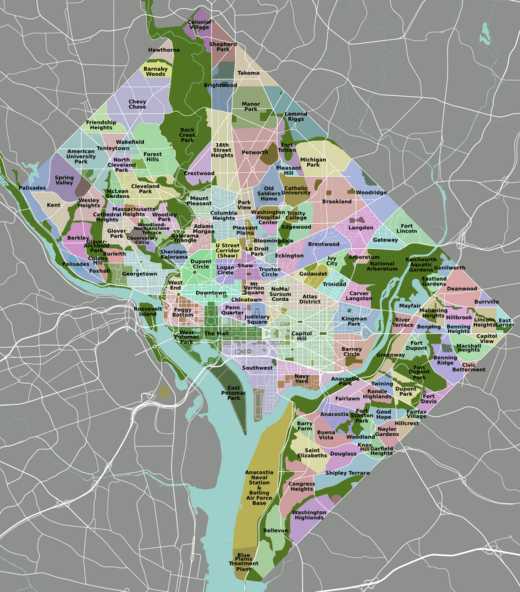
Neighborhoods in Washington, D.C.
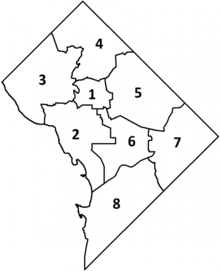
The eight wards of Washington D.C. (2012–2022). (Individual ward maps are for 2002–2011.)
As the capital of the United States, Washington's local neighborhood history and culture is often presented as being distinct from that of the national government.
List of neighborhoods by ward
Ward 1
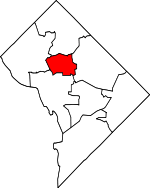
Ward 1
- Ward 1 Councilmember: Brianne Nadeau
- Population (2010): 74,462[2]
- Adams Morgan
- Columbia Heights
- Howard University
- Kalorama
- LeDroit Park
- Lanier Heights
- Mount Pleasant
- Park View
- Pleasant Plains
- Shaw (Parts of the neighborhood are also in Ward 2 and Ward 6)
- U Street Corridor (Part of the neighborhood is also in Ward 2)
Ward 2
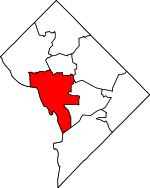
Ward 2
- Ward 2 Councilmember: Brooke Pinto
- Population (2010): 76,883[3]
- Burleith
- Chinatown
- Downtown
- Dupont Circle
- Federal Triangle
- Foggy Bottom
- Georgetown
- Logan Circle
- Mount Vernon Square (Part of the neighborhood is also in Ward 6)
- Penn Quarter
- Shaw (Parts of the neighborhood are also in Ward 1 and Ward 6)
- Sheridan Kalorama
- Southwest Federal Center
- U Street Corridor (Part of the neighborhood is also in Ward 1)
- West End
Ward 3

Ward 3
- Ward 3 Councilmember: Mary Cheh
- Population (2010): 78,887[4]
- American University Park
- Berkley
- Cathedral Heights
- Chevy Chase
- Cleveland Park
- Colony Hill
- Forest Hills
- Foxhall
- Friendship Heights
- Glover Park
- Kent
- Massachusetts Heights
- McLean Gardens
- North Cleveland Park
- Observatory Circle
- The Palisades
- Potomac Heights
- Spring Valley
- Tenleytown
- Wakefield
- Wesley Heights
- Woodland Normanstone
- Woodley Park (Part of the neighborhood is also in Ward 1)
Ward 4

Ward 4
- Ward 4 Councilmember: Brandon Todd
- Population (2010): 75,773[5]
- Barnaby Woods
- Brightwood
- Brightwood Park
- Chevy Chase (Part of the neighborhood is also in Ward 3)
- Colonial Village
- Crestwood
- Fort Totten
- Hawthorne
- Manor Park
- Petworth
- Riggs Park (also known as Lamond Riggs)
- Shepherd Park
- Sixteenth Street Heights
- Takoma
Ward 5

Ward 5
- Ward 5 Councilmember: Kenyan McDuffie
- Population (2010): 74,308[6]
- Arboretum
- Bloomingdale
- Brentwood
- Brookland
- Carver Langston
- Eckington
- Edgewood
- Fort Lincoln
- Fort Totten
- Gateway
- Ivy City
- Langdon
- Michigan Park
- North Michigan Park
- Pleasant Hill
- Queens Chapel
- Riggs Park (Part of the neighborhood is also in Ward 4)
- Stronghold
- Trinidad
- Truxton Circle
- Woodridge
Ward 6
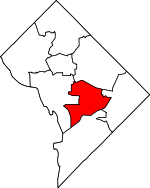
Ward 6
- Ward 6 Councilmember: Charles Allen
- Population (2010): 76,000[7]
- Barney Circle
- Capitol Hill
- Judiciary Square
- Kingman Park
- Mount Vernon Triangle
- Navy Yard
- Near Northeast
- NoMa
- Shaw
- Southwest Waterfront
- Sursum Corda
- Swampoodle (Neighborhood from the 1850s to the 1910s replaced in large part today by NoMa and Near Northeast)
Ward 7
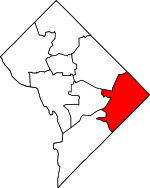
Ward 7
- Ward 7 Councilmember: Vince Gray
- Population (2010): 71,748[8]
- Benning Heights
- Benning Ridge
- Benning
- Burrville
- Capitol View
- Central Northeast
- Civic Betterment
- Deanwood
- Dupont Park
- East Corner
- East River Heights
- Eastland Gardens
- Fairfax Village
- Fairlawn
- Fort Davis
- Fort Dupont
- Fort Stanton
- Good Hope
- Greenway
- Hillbrook
- Hillcrest
- Kenilworth
- Kingman Park
- Lincoln Heights
- Marshall Heights
- Mayfair
- Naylor Gardens
- Northeast Boundary
- Penn Branch
- Randle Highlands
- River Terrace
- Skyland
- Twining
Ward 8

Ward 8
- Ward 8 Councilmember: Trayon White
- Population (2010): 73,662[9]
- Anacostia
- Barry Farm
- Bellevue
- Buena Vista
- Congress Heights
- Douglass
- Fairlawn
- Garfield Heights
- Knox Hill
- Shipley Terrace
- Washington Highlands
- Woodland
gollark: This sounds literally as secure as LMS.
gollark: ???
gollark: Sounds spoofable.
gollark: So any system using them is susceptible to spoofing.
gollark: IDs aren't an intrinsic part of the networking stack for CC.
References
- "Neighborhood Labels as Centroids". opendata.DC.gov. DC Office of Planning. Archived from the original on 30 May 2017. Retrieved 31 May 2017.
- Neighborhood Info DC: "DC Ward 1 Profile" Archived 2016-07-09 at the Wayback Machine retrieved June 30, 2016
- Neighborhood Info DC: "DC Ward 2 Profile" Archived 2016-07-09 at the Wayback Machine retrieved June 30, 2016
- Neighborhood Info DC: "DC Ward 3 Profile" Archived 2016-06-29 at the Wayback Machine retrieved June 30, 2016
- Neighborhood Info DC: "DC Ward 4 Profile" Archived 2016-07-01 at the Wayback Machine retrieved June 30, 2016
- Neighborhood Info DC: "DC Ward 5 Profile" Archived 2016-07-01 at the Wayback Machine retrieved June 30, 2016
- Neighborhood Info DC: "DC Ward 6 Profile" Archived 2016-07-14 at the Wayback Machine retrieved June 30, 2016
- Neighborhood Info DC: "DC Ward 7 Profile" Archived 2016-07-01 at the Wayback Machine retrieved June 30, 2016
- Neighborhood Info DC: "DC Ward 8 Profile" Archived 2016-06-22 at the Wayback Machine retrieved June 30, 2016
External links
| Wikimedia Commons has media related to Neighborhoods in Washington, D.C.. |
This article is issued from Wikipedia. The text is licensed under Creative Commons - Attribution - Sharealike. Additional terms may apply for the media files.
